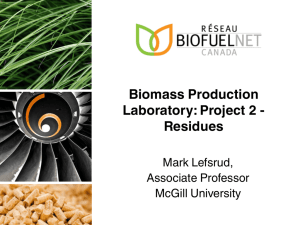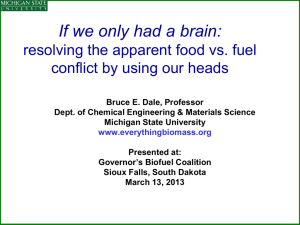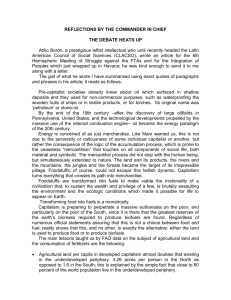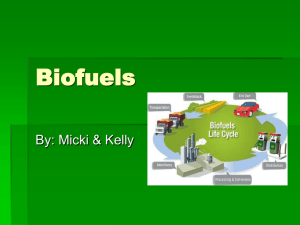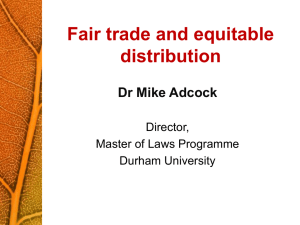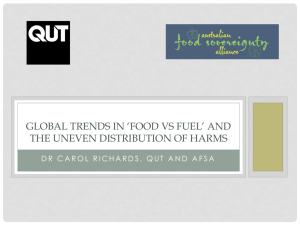Fuels of the Future
advertisement
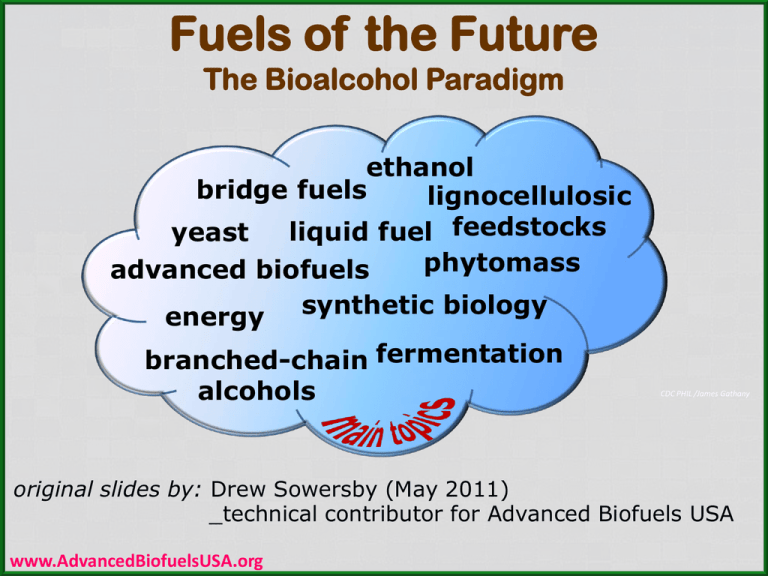
Fuels of the Future The Bioalcohol Paradigm ethanol bridge fuels lignocellulosic liquid fuel feedstocks yeast phytomass advanced biofuels energy synthetic biology branched-chain fermentation alcohols CDC PHIL /James Gathany original slides by: Drew Sowersby (May 2011) _technical contributor for Advanced Biofuels USA www.AdvancedBiofuelsUSA.org Message to the reader The following slide document has been created to inform a broad audience about the importance and likely dominance of bioalcohols in the transportation industry as the global transition from non-renewable fossil fuels to renewable advanced biofuels gains momentum. The information contained in these slides stands in support of the Advanced Biofuels USA mission. “The Mission of Advanced Biofuels USA is to promote public understanding, acceptance, and use of advanced biofuels by promoting research, development and improvement of advanced biofuels technologies, production, marketing and delivery; and by promoting the sustainable development, cultivation and processing of advanced biofuels crops, and agricultural and forestry residues and wastes.” These slides are for public consumption and can be duplicated, replicated, modified, adapted, distributed, transmitted, and/or shared as seen fit by the reader. Please credit sources accordingly. If you wish to modify this document, just add your name under mine on the first slide. Note: Some slides contain additional information in notes section below Concerted efforts from scientists, farmers, politicians, and grassroots organizations like Advanced Biofuels USA to understand and advocate for sustainability are ongoing. Most of us are seeking the promise of global security, the development of a sustainable workforce, and an endless supply of clean renewable energy. Converting biomass to biofuels for transportation fuel applications is currently one of the most active areas of investigative research in science and engineering. The following sections will offer an in-depth technical perspective of liquid fuels and demonstrate the overriding potential of bioalcohols to bridge transportation energy needs of modern society with the future of the human race. 1. Energy: The Root of All Civilization 2. Why Bioalcohols? Blending Bridges to Sustainability 3. Leaping Barriers: Squeezing the Sun Section 1 Energy: The root of all civilization In the beginning there was…..biofuels? 1 EJ = 1018 J The post civil war exploitation of coal helped spawn the Industrial Age, while the subsequent incorporation of crude-oil and natural gas fossil resources helped spawn what has become a global economy. Is this pattern sustainable? Most believe the answer to this question is NO! Why? In this section the ongoing energy crisis can be visualized in a series of graphs depicting the startling connection between: 1. 2. 3. 4. Energy Consumption GDP per capita (prosperity) Population growth Debt (deficit spending) chart by : http://perotcharts.com/2008/05/growth-of-us-population-1790-2050/ http://8020vision.com/2010/06/21/the-real-population-problem/ U.S. primary energy use by fuel (1980-2035) 120 Projections 1.0 × 1015 Btu 100 Biofuels 80 40% Liquids 60 Natural gas 40 Nuclear 20 Coal 0 1980 1995 2008 2020 U.S. Energy Information Administration (Washington, DC, June 2009) Projections: AEO2010 National Energy Modeling System 2035 Breakdown of the U.S. liquid fuel market • 35 quadrillion Btu’s (37 EJ) of liquid energy annually •~ 95% of all liquids since 1958 have come from petroleum 1 • 63% of refined petroleum was delivered to market as motor gasoline for transportation2 • less than 3% biofuels 1. Energy Information Administration, Annual Energy Review 2008, Petroleum Consumption: Transportation Sector, 1949-2008. 2009, U.S. Department of Energy, Washington, D.C 2. O’Donnell, M. Master’s Thesis, University of Texas at Austin, 2009 Global transportation energy consumption vs. GDP in 2006 graph from: http://environmentalresearchweb.org/blog/2009/07/high-debt-and-energy-return-on.html Energy and Economic Interconnectedness http://tclocal.org/images/failure-feedback.jpg Summary It appears there exists a positive correlation between energy consumption, population growth rate, GDP, and the abstractions of expanding debt and monetary instability. So now what? We must now consider alternatives to the current trends of fossil fuel dependence and moves toward sustainability. The next section will discuss the biofuels option with an in-depth analysis of the bioalcohol paradigm. Section 2 Why Bioalcohols? Blending Bridges to Sustainability What are biofuels? Biofuels are any biologically derived solid, liquid, or gas that stores energy used in combustion applications. In contrast to fossil fuels, biofuels…. 1. Are sustainable (1-100 yrs vs. 106-108 yrs) 2. Can be carbon neutral or negative 3. Have a more diversified, distributed means of production 4. Can be created as reagent grade molecules (pure) BIOFUEL TYPES Alternative Transportation Fuels Commercially available Methanol Natural Gas Propane Biodiesel Electricity Ethanol Hydrogen Under investigation and development Biobutanol Fischer-Tropsch (FT) diesel Gas to Liquids (GTL) Biogas Biomass to Liquids (BTL) Coal to Liquids (CTL) Hydrogenation-Derived Renewable Diesel (HDRD) P-Series (gasoline substitute) Source: The Energy Policy Act (EPAct) of 1992 biofuels biomass adapted by: Drew Sowersby Million Barrels per Day chart by: http://tclocal.org/images/eia-liquidfuels.jpg Source: U.S. Department of Energy’s Energy Information Agency (EIA). Million barrels day Global biofuel supplies expected to increase dramatically less than 2% of total liquid consumption more than 90% of all cars use sugarcane ethanol BP p.l.c., Statistical Review, BP Energy Outlook 2030, London, January 2011 The evolution of biofuels is defined in terms of the carbon feedstock used for production 1st generation fuels • corn-starch CO2 impact factor • sugar from cane and beets • soy for diesel 2nd generation – multi-component cellulose (medium to high lignin content) • switchgrass • miscanthus • agriculture and food processing residues • poplar trees net 0 3rd generation – high quality cellulose (low to no lignin) • microalgae • macroalgae (seaweed) •cyanobacteria 4th generation - sun fuels • carbon dioxide + light + biocatalyst… Bioalcohols currently dominate commercially available biofuels sugar feedstocks fermentation biomass The Bioalcohol Paradigm product recovery market 1 market 2 market 3 chemical Storage Biomass to Biofuels http://www.vsjf.org/project-details/13/biomass-to-biofuels-resources biomass process generalization bioalcohols Most cellulosic material, like woods and grasses, contains lignin Lignocelluloses represent the most abundant source of bioenergy Glucose Treatment with cellulases and/or acids releases glucose monomers for fermentation Rubin, E. Nature, 2008, 454, 841-845. But lignocellulosic feedstocks are not easily converted to sugar substrate and can introduce over 100 inhibitors into fermentation batches1 phenols organic acids CLASSES of inhibitors aldehydes ketones 1. Liu, Z. L.; Slininger, P. J.; Gorsich, Appl Biochem. Biotechnol., 2005, 124, 451-460. So far, Saccharomyces cerevisiae have demonstrated the ability to perform with a lignocellulosic feedstock. Advantages • Are the most common microorganisms used for production of biofuels (primarily alcohols) • Are eukaryotic • Have simple nutrient requirements • Are prime targets for bioengineering • Convert glucose to ethanol with unusual efficiency (FERMENTATION) The yeast cell factory has been used by humans for over 8000 years to create a host of useful renewable products Standard fermentation in yeast Glucose Glycolysis (regulated and irreversible steps) CO2 + H2O respiration amino acid synthesis CO2 + CH3CH2OH Fermentation Higher alcohol synthesis Ehrlich Pathway O2 Pyruvate Yeast cells naturally create C4 and C5 alcohols using fermentation enzymes BCAAs (leucine, valine, isoleucine) BAT1, BAT2 transamination (step 1) branched-chain alcohol synthesis 2-Keto acids PDC1, PDC2, PDC3, PDC5, PDC6, ARO10, THI3 (KID1) Ehrlich Pathway decarboxylation (step 2) Ketoaldehydes + CO2 NADH-dependent reduction (step 3) ADH1, ADH2, ADH3, ADH4, ADH5, ADH6, SFA1, etc. superior alcohol fuel surrogates Branched-chain alcohols 2MB 2MP 3MB Fermentation as a complex adaptive system Temperature Excess sugar pH Inhibitors Viscosity Biocatalyst Fluid Motion Gases (CO2 and O2) Nitrogen Source Ionic Strength Water Hypothetical Interaction Map Isobutanol (2MP) is a viable platform molecule GEVO, Inc. isobutanol conventional motor gasoline Highlights • High yield isobutanol yeast fermentation (105 g/L per batch) • Conversion to hydrocarbons • Carbon emissions reduction of 85% • Competes with oil at $65 a barrel source: GEVO, Inc. C4-C5 Alcohol Platform ButylFuel, LLC Highlights After logging 10,000 miles butanol…. • increased auto mileage by 9% • reduced oxides of nitrogen by 37% • reduced carbon monoxide to 0.01% • reduced hydrocarbons by 95% first American company to commercialize butanol Case Study: “Production of Butyric Acid and Butanol from Biomass” Ramey D and Yang S-T, Phase II STTR Final Report for D.O.E. (2004) C4-C5 alcohols have advantages compared to ethanol higher energy density lower vapor pressure lower air/fuel ratio less corrosive less hygroscopic higher gasoline blend ratios o “drop-in” fuel compatible with gasoline engines, existing storage facilities, and distribution infrastructure 1. Harvey, B. J.; Meylemans, H. A. J Chem Technol Biotechnol., 2011, 86, 2–9. 2. Dürre, P. Biotechnol. J., 2007, 2, 1525-1534. Selected bioalcohol and gasoline properties Boiling point (°C ) Solubility in water at 20°C (g/L) Vapor pressure at 20°C (mm Hg) Fuel Cn Energy density (MJ/L) Gasoline 4-12 33 38-204 negligable 275-475 Ethanol 2 21 78 miscible 59 2-methyl-1propanol* 4 26 108 95 9 3-methyl-1butanol 5 28 130 30 2 2-methyl-1butanol 5 28 128 36 (at 30°C ) 3 --information obtained from MSDSs, Sigma-Aldrich website, and NIST chemistry WebBook. * a.k.a. isobutanol ~ 1-butanol MJ/L Liquid Fuel Energy Densities butanol/pentanol sweet spot? MJ/kg Source:Scott dial http://en.wikipedia.org/wiki/File:Energy_density.svg Adapted by Drew Sowersby Right now fuel blends are showing up at pumps across the U.S. BRIDGE FUELS E10 o Up to 10% ethanol to replace MTBE E15 - E85 o contains 15% to 85% ethanol o requires post 2001 or Flexfuel engine technology B20 o contains 20% biodiesel / 80% diesel o made commercially from soybeans How long until we see C4 and C5 advanced alcohols at the pump? Section 3 Leaping Barriers: Squeezing the Sun The Obstacle Course It would be irresponsible to assume that human energy needs will be fulfilled in a timely fashion. The transition to sustainable energy will likely be a long arduous process. Moore’s Curse and the Great Energy Delusion (The American Magazine, November 19, 2008) “There is one thing all energy transitions have in common: they are prolonged affairs that take decades to accomplish, and the greater the scale of prevailing uses and conversions the longer the substitutions will take. The second part of this statement seems to be a truism but it is ignored as often as the first part: otherwise we would not have all those unrealized predicted milestones for new energy sources.” - Vaclav Smil-Distinguished Professor at the University of Manitoba. Technical Barriers GOAL Sheer size required for economic growth Geographic distribution START Supply continuity Low crop energy density Kerr, R. Science, 2010, 329, 780-781 The Bright Side The sun delivers about 1000 W/m2 of power to Earth’s surface. • 1000 Wh = 1 kWh = 3.6 mega Joules (MJ) • peak sun hour = 1 kWh • peak sun hours per day based on geo location http://pvcdrom.pveducation.org/SUNLIGHT/AVG.HTM U.S. example? ≈ 4.00 peak sun hours avg./day1 1 peak sun hour = 3.6 MJ 14.4 MJ/(m2)day × 365 days × 9.83 × 1012 m2 US land area ≈ 5.20 × 1016 MJ/year 1 MJ = 994.78 Btu ≈ 4.90 × 1019 Btu/year this is roughly 500X the current amount of US energy usage 1. Solar Radiation Data Manual for Flat-Plate and Concentrating Collectors National Renewable Energy Laboratory (NREL), 2006 Earth? ≈ 2.00-3.00 peak sun hours/day 7.2 MJ/(m2)day × 365 days × 5.14 × 1014 m2 ≈ 1.35 × 1018 MJ/year ≈ 1.28 × 1021 Btu/year “Using detailed land analysis, Illinois researchers have found that biofuel crops cultivated on available land could produce up to half of the world's current fuel consumption – without affecting food crops or pastureland. Adding LIHD (low input high density) crops grown on marginal grassland to the marginal cropland estimate from earlier scenarios nearly doubled the estimated land area to 1,107 million hectares globally, even after subtracting possible pasture land – an area that would produce 26 to 56 percent of the world's current liquid fuel consumption.” -http://cee.illinois.edu/cai_biofuel_land Published in the journal Environmental Science and Technology, the study led by civil and environmental engineering professor Ximing Cai identified land around the globe available to produce grass crops for biofuels, with minimal impact on agriculture or the environment. What will the next transition be? CO2 and the SUN NON-FOOD crops and waste/residues Paradigm Shift standard fermentation to advanced fermentation FOOD crops 1st generation biofuels 2nd generation biofuels Taking Us from the Present to the Future Many companies are engaged in making these transitions happen. See a list of more than 400 companies in the Resources section on the Advanced Biofuels USA web site: http://advancedbiofuelsusa.info/resources/compan ies-involved-with-advanced-biofuels Find out more at www.AdvancedBiofuelsUSA.org
